SPT-Fall2014
SPT-Fall2014
SPT-Fall2014
You also want an ePaper? Increase the reach of your titles
YUMPU automatically turns print PDFs into web optimized ePapers that Google loves.
I incorporated five body oriented<br />
techniques within my intervention<br />
tool including the following:<br />
Somatic Experiencing, Trauma<br />
Healing (SE TM ): developed by Dr.<br />
Peter Levine, this perspective is<br />
based on the regulation of the<br />
autonomic functions and of<br />
consciousness (self-regulation).<br />
Regulation inspired calibration.<br />
Regulation is about the balance<br />
between the sympathetic and<br />
parasympathetic autonomic<br />
subsystems. Calibration is about the<br />
constrictive force, tone/relaxation, of<br />
the organs and glands regulated by<br />
activation – deactivation signals of<br />
the ANS. Activation signal is<br />
constrictive, and deactivation signal<br />
is relaxing.<br />
Calatonia: developed by Dr. Pethő<br />
Sándor, this perspective specializes<br />
in gentle or subtle touch to stimulate<br />
epicritic sensory circuits. This<br />
stimulation provides relaxation to the<br />
global autonomic functioning.<br />
General sensory pathways ascend<br />
from the spinal cord to the thalamus<br />
and cerebral cortex. These pathways<br />
are grouped into two categories based<br />
on the type of information conveyed:<br />
epicritic, which is concerned with<br />
discriminative tactile and kinesthetic<br />
proprioceptive senses; and<br />
protopathic, which transmits pain,<br />
temperature, and itch. The<br />
protopathic may be an early warning<br />
indicator of external aggression and<br />
is in charge of the most primitive and<br />
diffused sensibility. Calatonia<br />
oriented me in adding protopathic<br />
stimulation to fully stimulate clients<br />
in order to achieve a healthy state of<br />
being.<br />
EMDR (Eye Movement<br />
Desensitization Reprocessing):<br />
developed by Dr. Francine Shapiro,<br />
this perspective is based on balancing<br />
the activity between both brain<br />
hemispheres. Each one has its own<br />
characteristics, complementing the<br />
other half. Traumas and signs are<br />
related to inter hemispheric nonintegration<br />
issues. MTC acquired<br />
bilateral exercises from this<br />
perspective.<br />
BMSA (Brief Multi-Sensory<br />
Activation): developed by Dr.<br />
Joaquin Andrade (Uruguay), Dr.<br />
Maarten Aalberse (France) and Dr.<br />
Christine Sutherland (Australia), this<br />
perspective is a neuro-physiological<br />
technique designed to use sensory<br />
stimulation to interrupt conditioned<br />
brain patterns. It suggests that<br />
emotional centers of the brain can be<br />
accessed by senses, equilibrium, and<br />
orientation. Flooding the amygdala<br />
through sensory stimulation produces<br />
desensitization.<br />
Havening Technique: developed by<br />
Dr. Ronald A. Ruden, this<br />
perspective also stimulates epicritic<br />
neuron circuits. While the client is<br />
describing a traumatic event, the<br />
therapist uses gentle touch to manage<br />
any resultant traumatic affective<br />
charge.<br />
Combining these tools with MTC, I<br />
have been able to strengthen clients’<br />
self-esteem as well as their<br />
autonomic activity (tone/ relaxation<br />
of the constrictive force of organs<br />
and glands), will power and control.<br />
Self – esteem is the appropriate term<br />
to address attachment issues. But for<br />
my perspective, ‘basic<br />
trust’ (Erikson, 1950) 1 is the<br />
appropriate term to find a somatic<br />
sensation (categorized as solidity,<br />
firmness, and strength) as a reference<br />
for emotional strength (trust). By<br />
providing clients with firm sensory<br />
stimulation throughout treatment,<br />
they improve their autonomic activity<br />
and basic trust, meanwhile reducing<br />
their anxiety level. Daily behavioral<br />
changes reported by my clients made<br />
this observation quite evident. For<br />
this reason, I believe that anxiety is<br />
the expression of unbalanced tone<br />
(mainly lack of strength). From a<br />
multilevel perspective (theosophical),<br />
somatic tone is strength, cognitive<br />
tone is attention, emotional tone is<br />
basic trust and sentimental tone is<br />
dignity. For this reason, all levels can<br />
be strengthened at the same time<br />
through simple somatic – cognitive<br />
exercises. I am also convinced that as<br />
basic trust (self-esteem) increases,<br />
anxiety decreases, sharing an inverse<br />
proportionality. While basic trust<br />
improves, will power, initiative, and<br />
limit setting become stronger. Being<br />
stronger allows clients to better<br />
control their thoughts, humor,<br />
anxiety, and their frustration<br />
tolerance is enhanced.<br />
From Somatic Experiencing® I<br />
learned that the first goal for a<br />
healing process is grounding and the<br />
second is awareness. From tone<br />
calibration perspective, grounding<br />
means connecting with solidity;<br />
awareness means focusing attention<br />
to certain stimulation to let it get into<br />
the brain for later processing in the<br />
amygdala during the sleeping stage to<br />
generate tone and relaxation tension<br />
for organs and glands. If attention is<br />
not present, the stimuli do not access<br />
the brain, provoking lack of material<br />
to develop somatic tone for proper<br />
autonomic functioning. Combining<br />
these two concepts with my<br />
experience with the autistic<br />
population I worked with during my<br />
18 month intensive practical training<br />
program at the Devereux Kenner<br />
Center, I developed Grounding<br />
Awareness Exercises. I was taught<br />
that Autism is defined as sensory<br />
integration issues. Through trainings<br />
and professional observations I<br />
arrived at the idea of calibrating the<br />
autonomic functioning through the<br />
senses. Through daily firm sensory –<br />
cognitive stimulation exercises (i. e.,<br />
spending 5 minutes being aware of<br />
solid surfaces: floor, wall, or table,<br />
while being in contact with them)<br />
performed at home, clients enhanced<br />
their global condition. Calatonia and<br />
Havening Techniques stimulate<br />
epicritic neuron circuits through<br />
subtle or gentle touch, so MTC starts<br />
by stimulating protopathic neuron<br />
circuits through solid touch then<br />
finishes with the epicritic ones.<br />
Epicritic circuits signal the sense of<br />
relaxation to the ANS distinguishing<br />
the different kinds of stimuli.<br />
Protopathic neuron circuits provide<br />
Somatic Psychotherapy Today | Fall 2014 | Volume 4 Number 2 | page 65


